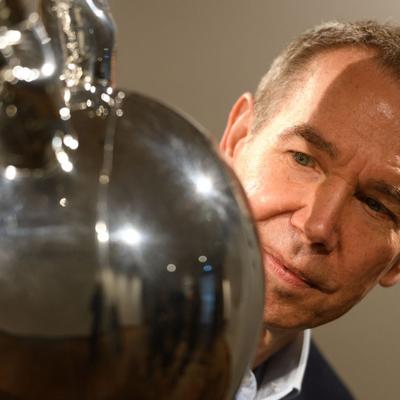Jeff Koons at a Glance
Jeff Koons’ Net Worth: A Deep Dive into the World of a Controversial Artist
Introduction: The Enigmatic Jeff Koons
Jeff Koons is one of the most successful and controversial artists of our time. Known for his bold, often oversized sculptures and installations, Koons has captivated the art world with his unique blend of pop culture, consumerism, and kitsch. But what is the true measure of his success? This article delves into the world of Jeff Koons, exploring his net worth, career, and the controversies that have defined his legacy.
Jeff Koons’ Financial Success: Net Worth and Auction Records
Jeff Koons’ net worth is estimated to be around $400 million, a testament to his significant financial achievements in the art market. His works consistently command high prices at auctions, solidifying his position as one of the most valuable living artists. From his early works to his more recent creations, Koons’ art has become a sought-after commodity.
Koons’ art has consistently broken auction records. His stainless-steel “Rabbit” sculpture sold for a staggering $91.1 million in 2019, setting a record for a living artist at the time. This landmark sale underscored the immense value and demand for his work.
Koons’ “Balloon Dog (Orange)” fetched $58.4 million, and “Hanging Heart (Magenta/Gold)” sold for $23.6 million, illustrating the high value his artwork holds in the art market. These figures highlight the financial success and the enduring appeal of his unique artistic vision.
Early Life and Educational Journey
Born on January 21, 1955, in York, Pennsylvania, Jeff Koons’ early life laid the foundation for his artistic pursuits. His parents, Gloria and Henry Koons, instilled in him an appreciation for aesthetics. His father’s profession as an interior decorator and furniture dealer exposed Koons to design and craftsmanship from a young age.
Koons’ early artistic endeavors included copying the works of old masters, indicating his early passion for art. His visit with surrealist artist Salvador Dalí in New York City further ignited his creative interests. He went on to study at the Maryland Institute College of Art and the School of the Art Institute of Chicago. There, he was influenced by artist Ed Paschke, for whom he later worked as a studio assistant, solidifying his trajectory in the art world.
From Wall Street to the Art World: Koons’ Career Shift
Before making his mark in the art world, Jeff Koons explored alternative career paths. Following college, Koons moved to New York City, where he worked at the Museum of Modern Art, a formative experience that exposed him to a wide range of artistic styles and movements.
In 1980, Koons briefly ventured outside the art world, working as a Wall Street commodities broker. He held positions at First Investors Corporation, Clayton Brokerage Company, and Smith Barney. This experience provided him with a unique perspective on finance and consumerism, themes that would later appear in his art.
The Rise to Fame: Pop Art and the Factory Studio
Koons rose to fame in the mid-1980s as part of a new wave of artists associated with the pop art movement. He established a studio in SoHo, modeled after Andy Warhol’s “Factory,” and employed a large staff to execute his projects, mirroring the production-line approach of his predecessor.
Koons gained notoriety with his sculptures depicting everyday objects, including vacuum cleaners and basketballs. His use of mass-produced objects, often presented in pristine condition, blurred the lines between high art and consumer culture. His focus on the mundane transformed into iconic works.
One of his most famous pieces is “Rabbit,” made in 1986. This series comprises three identical stainless-steel sculptures resembling inflatable balloon animal rabbits. This piece is a prime example of Koons’ ability to elevate ordinary objects into high art.
Exploring Koons’ Signature Works: Series and Controversies
Jeff Koons’ artistic career is marked by numerous series, each exploring different themes and concepts. He is known for his bold and often controversial choices. From the “New” series, featuring pristine vacuum cleaners, to the “Banality” series, with its porcelain figurines, Koons consistently pushed boundaries.
The “Banality” series, launched in 1988, further cemented his international fame. Most notably, this collection included the piece “Michael Jackson and Bubbles,” a life-size gold-leaf-plated porcelain sculpture depicting the singer and his pet chimpanzee. These pieces showcased his ability to provoke reactions and generate debate.
The “Made in Heaven” series, featuring explicit depictions of himself and his then-wife Ilona Staller, caused significant controversy. In contrast, Koons’ created “Puppy,” an enormous topiary sculpture, to regain public favor. Koons’ “Celebration” series, comprising large-scale sculptures and paintings of balloon animals and diamonds, has become particularly renowned.
Among his other notable series are “Tulips,” “Easyfun,” “Popeye,” and “Hulk Elvis.” He created the enormous “Split-Rocker,” his second topiary sculpture, and the “Antiquity” series, including pieces like “Metallic Venus,” “Ballerinas,” and oil paintings depicting classical sculptures.

Getty
Beyond Sculptures: Other Ventures and Collaborations
Beyond his sculptural works, Jeff Koons has engaged in various other artistic endeavors, including curation. In 2009, he curated an Ed Paschke exhibit at New York’s Gagosian Gallery. He also curated an exhibit of works from the private collection of billionaire Dakis Joannou at the New Museum in 2010.
Koons has also collaborated with several other artists, including Martin Kippenberger and Lady Gaga. He designed the cover of Lady Gaga’s third studio album, “ARTPOP.” Furthermore, he partnered with the luxury fashion house Louis Vuitton to design a series of handbags and backpacks, further extending his reach into popular culture.
Koons in the Art Market: Value and Collectors
Koons’ artwork has a significant impact on the art market. His pieces are widely collected in North America and Europe. Many of his sculptures and installations command high prices at auction, reflecting the high value assigned to his work.
In 2001, one of Koons’ “Michael Jackson and Bubbles” sculptures sold for $5.6 million. Later, in 2007, his “Hanging Heart (Magenta/Gold)” sold for $23.6 million. His “Balloon Dog (Orange)” fetched $58.4 million in 2013, and “Rabbit,” went for $91.1 million in 2019.
Criticism and Controversy Surrounding Koons
Despite his success, Jeff Koons and his work have faced their share of criticism. Some view his work as embodying crass commercialism, particularly through its kitsch aesthetics and self-promotion. Others have criticized his extensive use of preexisting images and his copyright infringement lawsuits.
Koons has been sued numerous times for copyright infringement. He has lost many of these lawsuits. These criticisms underscore the complex relationship between art, commerce, and originality that characterizes his work.
Personal Life: Relationships and Family
Koons’ personal life has also been marked by significant events. While attending the Maryland Institute College of Art, he had a daughter named Shannon Rodgers whom he put up for adoption. Later, he married porn star and Italian politician Ilona Staller in 1991. The couple had a son, Ludwig, before divorcing in 1994 due to allegations of abuse.
Following his divorce from Staller, Koons married fellow artist Justine Wheeler, and they have six children together. In 2007, they founded the ICMEC Koons Family Institute on International Law and Policy, which is associated with a global nonprofit committed to ending child sexual exploitation.
Conclusion: The Enduring Legacy of Jeff Koons
Jeff Koons’ net worth, estimated to be around $400 million, reflects his success and influence in the art world. He remains one of the most talked-about and commercially successful artists of our time. His ability to captivate audiences, spark debate, and command extraordinary prices at auction ensures that his name will continue to resonate within the art world. His unique blend of pop culture, consumerism, and kitsch ensures his work will continue to be debated for years to come. The legacy of Jeff Koons is one of both artistic innovation and commercial success.

